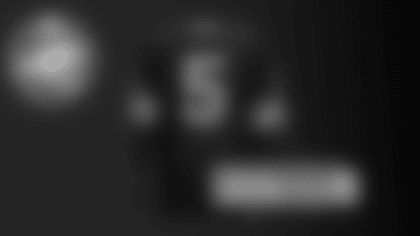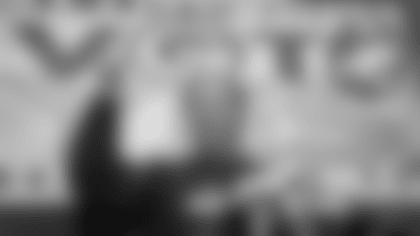Joe from Watertown, WI
What was the decision-making process for the Packers playing home games in Milwaukee, especially the 1939 NFL Championship at State Fair Park?
It was all about survival.
On Aug. 15, 1933, the Packers went into receivership and Frank Jonet, a Green Bay accountant, was appointed receiver of the Green Bay Football Corporation, the community property that had been running the Packers since 1923. Years later, Jonet said when Judge Henry Graass named him receiver, he handed him $76.18, along with judgments and unpaid bills amounting to more than $15,000.
Less than a month later, the Packers announced that they were moving their third home game of the season against the New York Giants to Milwaukee's Borchert Field. Prior to the announcement the Packers had received a letter from NFL president Joe Carr informing them: "Every day I await the Green Bay paper with a good deal of interest…" While Carr expressed optimism that the Packers would find a way to field a team that season, he also admitted concern about their plight and growing hurdles. "We certainly want to keep Green Bay in the league," Carr continued. "The Packers are one of our greatest attractions."
The announcement that the Packers were going to play the Giants, one of the most attractive games on their schedule, didn't go over well in Green Bay. "Here and there about town can be heard howls of calamity because the Packer management has decided to shift the Green Bay-New York Giant game to Milwaukee," Art Bystrom, sports editor of the Green Bay Press-Gazette, wrote as the lead to his column three days later.
But it turned out to be a marriage made in heaven – to borrow an ageless idiom. If Milwaukee had not become a second home to the Packers from that date forward, they almost certainly wouldn't have survived.
The Giants game drew 12,467 fans, the Packers' largest home crowd of the season, and was obviously a financial success, although the visiting team won 10-7. Other than the Bears game, which drew a similar size crowd to old City Stadium, the attendance for the Packers' other four games in Green Bay that season were reported as 5,000, 5,200, 4,000 and 3,007.
The Packers had previously played at Borchert Field, a bandbox minor league baseball stadium located on a city block bordered by Burleigh, Chambers, 8th and 7th streets, when it was called Athletic Field. Included were two non-league games against Racine at the end of their 1921 and '22 seasons, and the Packers' road games against the Milwaukee Badgers, when they were members of the NFL from 1922-26. But after the 1933 game, Curly Lambeau was so unhappy with the field and seating arrangements that he vowed never to play there again.
Nevertheless, in August, 1934, with the Packers still in receivership, they agreed to play two league games that season at State Fair Park, located just outside Milwaukee, as well as a midseason exhibition game against the Chicago Bears.
Played under the lights, the exhibition turned out to be the most hyped game of the three and drew 10,000 fans. It ended in a 10-6 Bears victory, and as most games in the rivalry did back then, it incited some raw emotions among Packers fans. One took it to an extreme. Irate over head linesman George Lawrie's calls, he chased him down as he was leaving the field, knocked him to the ground with a solid right to the jaw and escaped off into the night without ever getting caught.
On Feb. 19, 1938, NFL owners voted unanimously at the urging of Packers president Lee Joannes to extend Green Bay's territory to include Milwaukee. Just as significantly, on Jan. 23, 1947, with television coming into the picture, NFL owners again voted unanimously to give the Packers territorial rights to Milwaukee even though the distance between the cities exceeded the 75-mile limit that had been agreed upon.
As for playing the 1939 NFL Championship at State Fair Park, that was far more controversial than playing that first game at Borchert Field. It was a decision reached on Nov. 28 during a meeting in Pittsburgh among club officials of the teams in contention for the title. While they might have been pressured by league officials, it was the Packers' brass that made the decision for economic reasons. The players split the gate and a game in Milwaukee figured to take in $30,000 more than one in Green Bay.
Outraged fans grumbled in the bars, the barber shops and on the street corners of Green Bay, and also flooded the Press-Gazette with critical letters. "You have done the fans of Green Bay and surrounding territory an injustice, which will take a mighty long time to undo," wrote one.
Still, thousands of Green Bay fans traveled to Milwaukee for the game and celebrated their team's 16-7 victory over the Giants and fifth NFL title.
Ron from Broken Arrow, OK
I know the Packers played in Milwaukee from 1933-94, while also playing in Green Bay. I know most seasons the Packers played more games in Green Bay than Milwaukee. However, if my research is correct, the Packers played the same number of games in Green Bay and Milwaukee in the following seasons: 1941, '43, '47, '48, '49, '52, '53, '54, '55, '56, '57, '78 and '80. I'm presuming the reason in the 1940s and '50s was financial, even though it appears attendance in both cities was comparable. I'm more puzzled why there were four games in 1978 and '80 in both Green Bay and Milwaukee.
First, your research is correct. And your presumption about the 1940s and '50s is essentially correct. But let's start there. Clearly from 1941-57, the Packers were in dire financial straits for much of that time. But there were other determining factors at play, as well.
In 1941, the Packers' season ticket sales in Green Bay totaled 2,878 and that was a franchise record. That also was the year when Curly Lambeau returned from the NFL's annual meeting with no guarantee that he'd find a third opponent willing to play in Green Bay. Only the Bears and Lions, the two teams that could usually count on drawing large crowds there, had agreed to play in old City Stadium, which had recently been expanded to seat roughly 25,000 fans.
Furthermore, NFL owners had talked in recent years about turning the Packers into a traveling team because they had generally been the league's biggest draw when they played on the road while also ranking near or at the bottom in home attendance.
"This problem is getting tougher all the time," Joannes, who was still club president, said In August 1941 when he was trying to galvanize the city's large companies to buy more season tickets and to encourage their workers to buy them. "Teams like the (Chicago) Cardinals and Cleveland Rams have found that they get much more in gate receipts when they play us in Milwaukee than when they play in Green Bay."
You're right that attendance didn't always reflect that. That season, the Cardinals played in Milwaukee in October and drew 10,000 fans, then played in Green Bay in mid-November and drew 15,495. On the flip side, the crowd for the Packers' season opener against the Lions in Green Bay was 16,734, whereas the Cleveland Rams played before 18,463 in Milwaukee the next Sunday.
In 1943, when the Packers played only four of their 10 league games at home, it was largely due to World War II and government rationing, including the restrictions placed on gasoline and tires. The NFL was being criticized for playing games when ordinary citizens were being asked to limit their spending on food and other essentials.
Consequently, the Packers posed a particular problem because they were the only team not located in a large metropolitan area where public transportation was easily accessible to fans attending games. That year, there was even discussion about forcing the Packers to play home games in Buffalo and/or Akron, Ohio, to alleviate those concerns. In the end, the Packers played only two games in Green Bay and two others in Milwaukee.
Here was another consideration.
Prior to 1940, the Packers had never played a game in Green Bay later than Nov. 15. But once they started scheduling more home games in colder weather, especially during deer hunting season, they struggled to sell tickets to those late games. It also was why many fans balked at buying season tickets in Green Bay; they weren't likely to use them for late November games.
In 1946, for example, when the Packers played three home games in Green Bay, they drew 25,049 for the season opener against the Bears; 22,588, for an Oct. 20 game against Pittsburgh; and only 16,150 for a Nov. 24 game against the Cardinals. And that was just two years after the Packers had won their final NFL title under Lambeau. By comparison, the crowds for the Packers' two games in Milwaukee in 1946 numbered 27,049 and 23,564.
I'm guessing that influenced the decision to split the games 3-and-3 in 1947, and it paid off. Average attendance in Milwaukee was 30,086, while it was 25,400 in Green Bay.
From 1953-56, Milwaukee had a new, larger stadium, whereas old City Stadium had become the last surviving relic from pro football's dark ages. Yes, during their first six years in County Stadium, the Packers played before fewer than 20,000 fans eight times. Yet Milwaukee's potential as a pro football city was evident when 40,199 fans filled County Stadium on Oct. 8, 1955, to watch Alan Ameche, a Kenosha, Wis., native and University of Wisconsin Heisman Trophy winner, play his third professional game with the Baltimore Colts. That was almost 20,000 more than the Packers had ever drawn in Green Bay.
It was because of these one-after-another, life-threatening perils over the Packers' first 30-plus years that we titled our four-volume history, “The Greatest Story in Sports,” and included considerably more detail about all such developments.
As for 1978 and '80 – well, let's start by noting the schedule called for the Packers to play four games in each city again in 1982; and, as a result, because of the players' strike that season that forced the cancellation of seven games, they played only one regular-season game in Green Bay and three in Milwaukee.
My recollection is that the decision to play an equal number of games in Green Bay and Milwaukee at that time didn't stir much of a fuss. It was announced on Dec. 6, 1977, roughly four months before the 1978 NFL schedule was released. The contents of the team's press release were twofold: That a ticket price increase for 1978 announced a little more than two months earlier was being reversed; and that over the next two years, the eighth home game, would be rotated between the Packers' two homes. In 1978, Milwaukee would get the game and the split would be 4-4; in '79, it would go to Green Bay, giving that city five games.
The Packers' executive committee had deliberated over the matter for most of the year and decided in September 1977 to survey ticketholders in each city before making a decision. The Packers never released the results of the survey but said fans in both cities wanted the extra game.
There was speculation, however, that a sizeable number of fans weren't excited about paying for an extra game and didn't care much if their ticket package included four games or five.
Remember those were troubled times: two miserable seasons to end the Dan Devine era and three more disasters to start the Bart Starr era. And the previous season was the worst of all.
In 1977, Starr elected not to name an offensive coordinator and took charge of the offense himself. The result was the Packers scored 24 points in a season-opening win over New Orleans and 16 in a victory over San Francisco in their season finale, but in between won only two of 12 games and scored 10 or fewer points in 11 of them.
Financial considerations could have been another factor. Net income had dropped more than 40 percent in 1977 from $455,597 to $266,810.















